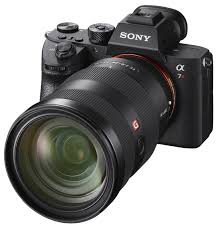Sony ILCE-7RM3 Feature Overview
Sony ILCE-7RM3 appeared in our editorial office immediately after the announcement, however we are releasing a large review in the format of “Week with an Expert” just now. And there is one good reason. We wanted to understand this camera in detail in order to understand whether it is really as cool as its characteristics say. Check price Sony ILCE-7RM3 This is the first camera from the third generation of "sevens". Do not confuse it with the slightly newer Sony A7 III , which came out a little later and has already been tested by us. The number of small and large improvements compared to the previous generation is simply huge. Using the Sony ILCE-7RM3 as an example, we can clearly see how Sony developers listen to the opinions of photographers, creating the next product. In April 2016, several Russian photographers personally transmitted their wishes to Sony headquarters. We even prepared an article about this trip . It is noteworthy that even the wishes not mentioned in the article were taken into account in ILCE-7RM3. In the third “seven”, the only unchanged nodes were the bayonet mount and matrix. Yes, yes, it is the matrix that all camera manufacturers are striving to modernize in the first place. Probably, if Sony could improve it, they would improve it. But the 42-megapixel full-frame sensor, familiar to us from ILCE-7RM2, seems to be well ahead of its time and still looks almost the best on the market.ILCE-7RM3 / FE 24-105mm F4 G OSS Installations: ISO 100, F11, 3 s, 24.0 mm equiv.Download RAW
Say for this, thanks to backlight technology that allows you to increase the size of each individual photosensitive cell by transferring the conductors surrounding the pixel to the lower layer of the crystal. As a result, we have high resolution without harm to the size of the photosensitive cell (we intentionally do not say “pixel”, because this is not the same thing).
Changes begin with a matrix binding. Both her and the processor were “overclocked”. This is primarily seen in the speed of serial shooting. If in ILCE-7RM2 it was up to 5 frames / s, then in Alpha 7R Mark III it increased to 10 frames / s with autofocus.
The buffer and work with memory cards have also been seriously upgraded. Now a continuous series of RAW + JPEG can be more than ten seconds at maximum shooting speed. To save frames, two memory card slots are used, one of which supports SD UHS-II.
The appearance of the camera at first glance has not changed ... But this is only at first glance! Experienced sonivods will immediately see a new control on the rear panel - the joystick. He is responsible for direct selection of the focus point. And this is not the only way to select the focus area. The screen has now become touch-sensitive, albeit with limited functionality: you can set the autofocus point, control viewing, but you cannot navigate through the menu and change the shooting parameters.
The viewfinder, which performed well in the ILCE-7RM2, has been further enhanced. Now its resolution is 3.7 million points.
Housing parts are made of metal. The case has a dust and moisture protection.
Another pride of the seventh Alpha series of the second generation is the built-in optical stabilizer based on matrix shift. It has also been finalized. Now the stabilizer can compensate for up to 5.5 shutter speeds when shooting handheld, of course, according to the manufacturer. In our test, we will determine what the real gain is. And the stabilizer now allows you to shoot frames with increased detail in Pixel Shift mode. The camera is capable of making a series of four frames with a shift of exactly one pixel. Then the pictures are combined into one frame with honest pixel-by-pixel sharpness. We will also tell you more about this in the test.
The list of minor improvements is continued by the appeared Type-C connector, which can be used including for charging and powering the camera.
But a much more important improvement was the use of a large NP-FZ100 battery, as in ILCE-9. And this did not entail a significant increase in the dimensions of the case. The life of a single charge has increased significantly: 530 and 650 shots (using CIPA measurement technology) in the case of shooting through the viewfinder or using the screen, respectively. The same battery grip fits the camera as the Nine - VG-C3EM.
In conclusion of the brief review, mention should be made of video capabilities. The camera still writes both Full HD and 4K from the entire width of the matrix, allowing you to use S-Log gamma curve profiles, focus picking, zebra and other professional tools. Now let's talk about each aspect in more detail in our “Week with an Expert” test.


